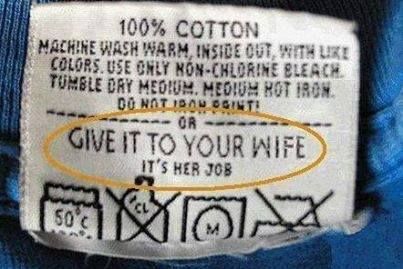Always Wash Anything You Can From Store
What's in your new brand name clothing?
After clothes are made, they are often covered with formaldehyde to keep them from wrinkling or becoming mildewed during shipping. Formaldehyde as a preservative also adds to vaccines' toxicity.
Several severe allergic reactions to formaldehyde have been reported. It's no wonder. Investigations have discovered up to 500 times the safe level of formaldehyde in clothing shipped to brand name clothiers form factories in China and Southeast Asia.
There's also the long term, negative, cumulative effect on health that is almost impossible to trace back to any source of clothing chemicals. Formaldehyde and other toxic chemicals are used to create synthetic fibers for towels and bedding. Textile toxins are hard to avoid even when you're out of your clothes.
Another commonly used clothing chemical is nonylphenol ehtoxylate (NPE). NPE use is restricted in most regions where the big name brand clothes are sold. But there are no restrictions where the clothing factories are located in China and Southeast Asia. 14 big name brands get their clothing from clothing factories using NPE.
Wrinkle free or no-iron should be considered a warning for carcinogenic perfluorinated chemicals (PFCs). Teflon for pans is a PFC. Petrochemical dyes are used for fibers in those Asian textile factories that profusely pollute nearby waterways.
Dr. Richard Dixon of the World Wildlife Federation warns about the ecological impact on wildlife: "Urgent action is needed to replace hazardous chemicals with safer alternatives especially in clothing and other consumer products." (Emphasis added).
Nonylphenol ethoxylates (NPEs) are commonly used as detergents in textile industries abroad that are contracted by multi-national USA and EU-based clothing companies. NPEs break down to form nonylphenol, a toxin with hormone-disrupting properties similar to BPA. (http://www.naturalnews.com)
Black clothing and dyes for leathers often contain p-Phenylenediamine (PPD), which can produce allergic reactions. Flame retardants can appear in bedding and nightwear. Volatile organic compounds (VOCs) and dioxin-producing bleach are used by textile industries. Athletic shoes that contain cloth contain some of these toxins.
What's in your new brand name clothing?
After clothes are made, they are often covered with formaldehyde to keep them from wrinkling or becoming mildewed during shipping. Formaldehyde as a preservative also adds to vaccines' toxicity.
Several severe allergic reactions to formaldehyde have been reported. It's no wonder. Investigations have discovered up to 500 times the safe level of formaldehyde in clothing shipped to brand name clothiers form factories in China and Southeast Asia.
There's also the long term, negative, cumulative effect on health that is almost impossible to trace back to any source of clothing chemicals. Formaldehyde and other toxic chemicals are used to create synthetic fibers for towels and bedding. Textile toxins are hard to avoid even when you're out of your clothes.
Another commonly used clothing chemical is nonylphenol ehtoxylate (NPE). NPE use is restricted in most regions where the big name brand clothes are sold. But there are no restrictions where the clothing factories are located in China and Southeast Asia. 14 big name brands get their clothing from clothing factories using NPE.
Wrinkle free or no-iron should be considered a warning for carcinogenic perfluorinated chemicals (PFCs). Teflon for pans is a PFC. Petrochemical dyes are used for fibers in those Asian textile factories that profusely pollute nearby waterways.
Dr. Richard Dixon of the World Wildlife Federation warns about the ecological impact on wildlife: "Urgent action is needed to replace hazardous chemicals with safer alternatives especially in clothing and other consumer products." (Emphasis added).
Nonylphenol ethoxylates (NPEs) are commonly used as detergents in textile industries abroad that are contracted by multi-national USA and EU-based clothing companies. NPEs break down to form nonylphenol, a toxin with hormone-disrupting properties similar to BPA. (http://www.naturalnews.com)
Black clothing and dyes for leathers often contain p-Phenylenediamine (PPD), which can produce allergic reactions. Flame retardants can appear in bedding and nightwear. Volatile organic compounds (VOCs) and dioxin-producing bleach are used by textile industries. Athletic shoes that contain cloth contain some of these toxins.






